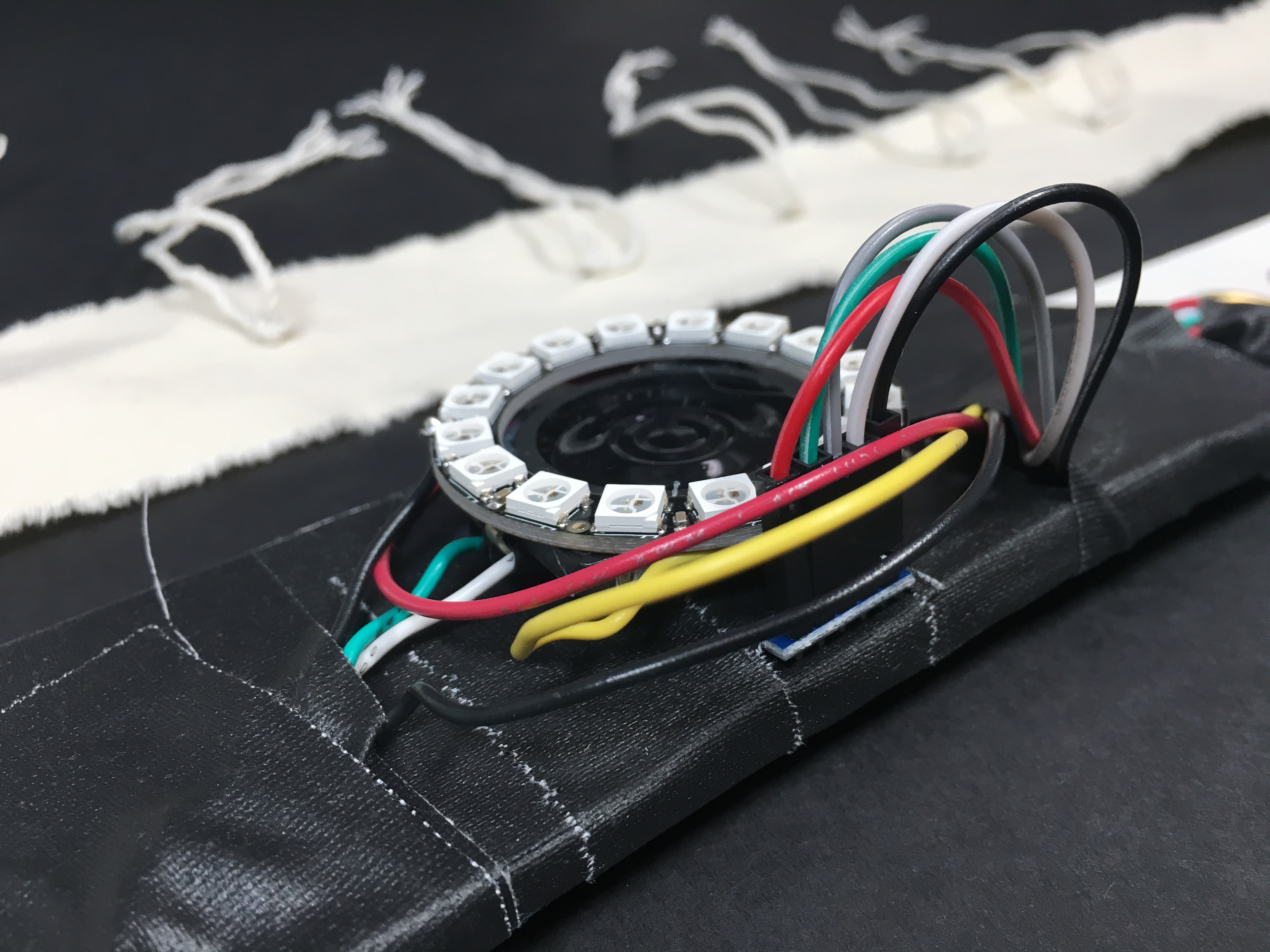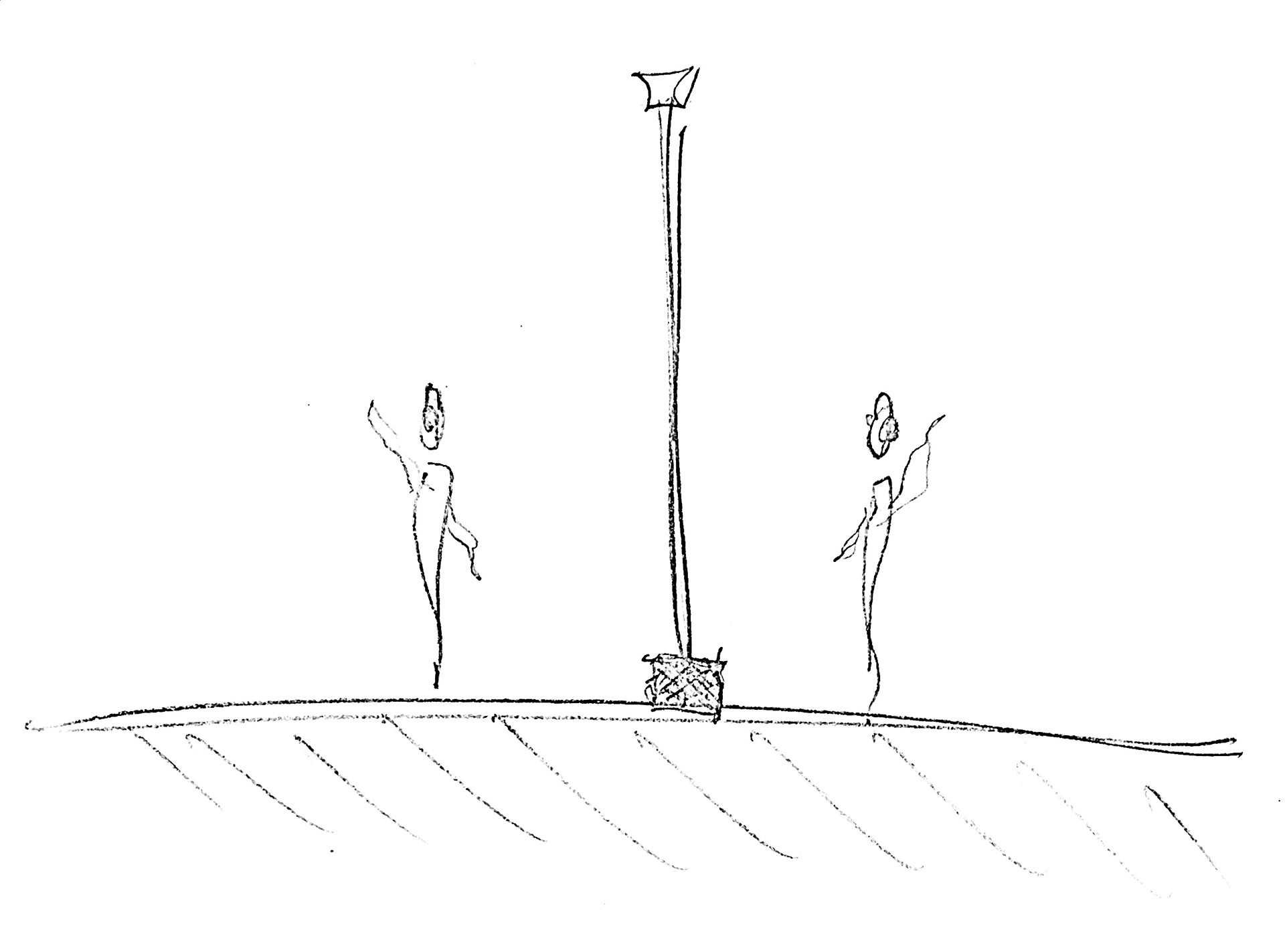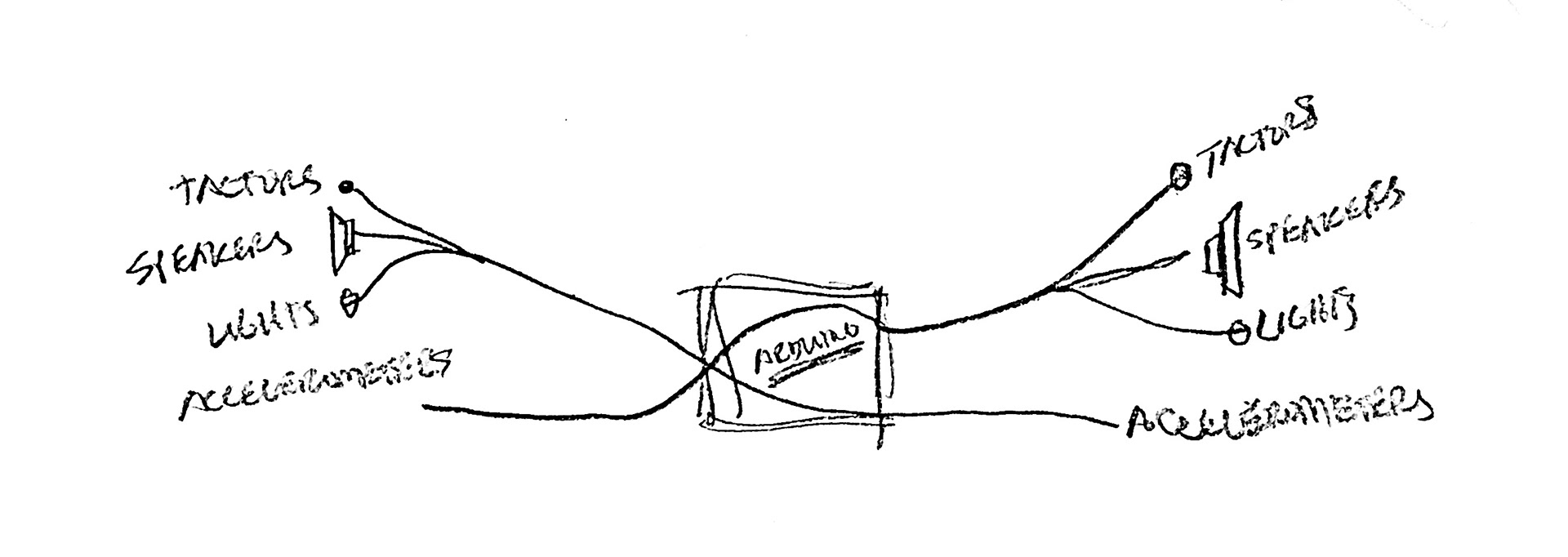Project Statement
Blind Understanding is a performance piece where two individuals stand on opposite sides of a curtain and are equipped with accelerometers which monitor and capture their movement. This information is then sent through digital signals to create a combination of vibration and music for the opposing person to experience, who can then process that information which can impact their movement. Sited in the IDeATe's Media Lab to provide an intimate space for the dancers to perform and through movement communicate, the project aims to allow for the users to speak through a different medium and feel the presence of the other individual. The dancers will be blocked from each other’s view due to the position of the curtain, but will be free to move as they please (within the confines of the reach of wires). The goal of the exhibit is to convey and to exercise the reading of movement through technology that may reveal information and emotion that otherwise may not be within our frame of perception.
This concept was derived from John Berger’s Ways of Seeing in which he describes how photographs are inherently subjective to the control of the photographer. This was applied to an idea about how people see past one another and attempting to create an experience that brings people together in an experience driven by a focus on the senses rather than language to communicate. This concept is related to my interest in the ways that people explore and interact with space as well as other people. Introducing a visual limitation, changes the ways in which people move and act within a space. In addition, communicating in an intimate environment where one is separated from the other begins to tie into ideas of technology and the distortion of distance that it allows. The concept tries to propose an alternate future where one can sense through a call the physical movements of the person they are communicating with in ways not just visual in nature. In a sense, even with the vast access to technology today, people can have almost immediate access to a windowed view of someone else's life. Even so, this window allows for deception, for misdirection, for the untold. As such, to embed smart clothing with the ability to read how other people feel would be an intriguing thought experiment: a world where lying becomes almost impossible, where understanding others fears and anxieties is simple, where empathy is built into our lives.
The project is also reflective of my perception of how I interact with others as someone who is more introverted and reserved, and has become constructive criticism, as well as encouragement, for myself to express and to confide in others more frequently.
Photography Credit: Dave Choi
Project Images







Project Process Documentation
The initial idea was to have two lines of communication between two users that abstracted information about the other persons movements that would influence the users' movement without being able to see one another. In developing the concept, most of the concept remained the same, except for the lights which became feedback for the dancers themselves to know that their movements were causing a fluctuation in the data being sent across to the other person. Many outputs were also scaled up to give more specific feedback. It took multiple vibration motors to convey directional motion to the dancers and the lights needed to be programmable so that the dancer could perceive the change in data flowing to the other side of the curtain. The main question, however, was the form that the project would take in latching on to each user and how it would fulfill all of its necessary functions. The final piece would have to not only house all of the sensors and outputs, but would have to connect each element to the corresponding Arduino pin using lengthy wires to allow for reasonable range of movement for the performers. Furthermore, the piece would have to be flexible and adaptable to anyone that would want to test it out. Lastly, the aesthetic of the piece needed to respond to the limitations of the wiring and allow for the most freedom of movement that was possible.






Process Reflection
The process of this project was a bit bumpy to be honest. I was fairly confident throughout the process that I would be able to get the electronics working, but I took too much time to assess fabrication processes. I ran into issues with the photogrammetry program I was using with the images I was inputting and the modeling for the CNC-ing was heavily reliant on the 3D model that the photogrammetry software would output. I burned a lot of time trying to get the initial idea to work, and took too long to bail. In addition, the garment design was a huge undertaking given my ambitions. As I didn’t have two specific designated people to perform, I had to make sure that the final design would be able to fit anyone (although that would have been my intent either way, I suppose). Many of the solutions to allow for more flexibility can only be described as “jank”, but they did function as intended and the piece seems to perform well in that context. Although it worked out in the end, the final project wasn’t as integrated between the technology band and the origami sculptural piece as I would have hoped. In some of the imagery, you can clearly see issues with dancers having wires lifting the origami piece or dealing with wires threaded under their arms.
In regards to technology, the DFRobot Mini MP3 Player was a massive asset to allow for the Exploded Ensemble’s music to play, but was also very finicky at times, with some functions not working and general troubleshooting occurred very often. In regards to the LED feedback, I managed to get it to the point where different movements clearly made different light patterns and colors, but I would have liked to further develop that so that people can better understand what data was being collected from their movements. I think the vibration was also a point that could have been composed better. The vibration motors were definitely felt, but because the two motors on each garment were attached to the same piece of plastic, the sensation of the motors was more easily confused or lost than I would prefer. Lastly, the general use of wires felt really wasteful. The concept would have been weaker and more fragile if the lengths had been shortened, but in the future it might be better to consider ways to reduce that sort of excessive expenditure of materials.
Conceptually, the review and feedback was very helpful to give insight on how others saw the project in how it was presented and in how it functioned. The project would have been more compelling if I had taken more strides to introduce the rules of the project beforehand or if I had choreographed a dance that would provide an intriguing performance for the audience. In addition, the idea of a goal or of stakes was frustrating because one of the original ideas that I had was to give dancers a prompt (through a piece of music or through text) that they would be trying to convey to the other dancer. I think if more planning had gone into this part of the project, it would have had much more depth and would have incentivized the dancers to reach for a specific goal. Looking forward, I want to consider perhaps implementing myself into the final project and becoming a performer. The goal of designing a performance sat in the backseat for this project mostly because I was overly concerned about the fabrication, functionality, and aesthetics of the project. Moving forward, I want to expedite the fabrication portion to allow more time to consider the other intriguing performance aspects of the work, or to stay diligent on implementing these ideas earlier on in the process.
To learn more about the project's design process, code, and lessons, follow this link!









